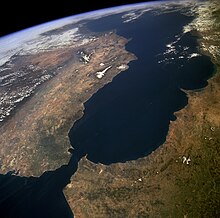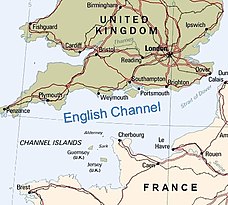Choke point
This article needs additional citations for verification. (August 2008) |

In military strategy, a choke point (or chokepoint), or sometimes bottleneck, is a geographical feature on land such as a valley, defile or bridge, or maritime passage through a critical waterway such as a strait, which an armed force is forced to pass through in order to reach its objective, sometimes on a substantially narrowed front and therefore greatly decreasing its combat effectiveness by making it harder to bring superior numbers to bear. A choke point can allow a numerically inferior defending force to use the terrain as a force multiplier to thwart or ambush a much larger opponent, as the attacker cannot advance any further without first securing passage through the choke point.
Historical examples
[edit]Some historical examples of the tactical use of choke points are King Leonidas I's defense of the Pass of Thermopylae during an invasion led by Xerxes I of Persia; the Battle of Stamford Bridge in which Harold Godwinson defeated Harald Hardrada; William Wallace's victory over the English at the Battle of Stirling Bridge (Wallace had around 2,300 men against the English army of about 9,000 to 12,000 men and the bridge collapsed during the battle); and the Battle of Agincourt in which Henry V of England decisively defeated the French using a small army (consisting mainly of lightly equipped longbowmen) when the much larger force of French heavy cavalry were forced to charge at the Englishmen through a narrow muddy gap in the Azincourt Woods.
The many archipelagos of the Caribbean offered several maritime choke points that attracted pirates and buccaneers during the height of their activities in the 17th and early 18th century.[citation needed] The Spanish treasure fleets leaving the Americas would have to pass through those waters to pick up the strong, prevailing westerly winds that would take them back to Spain across the North Atlantic.
Some choke points, with important locations in parentheses:
- Strait of Hormuz passage from the Persian Gulf to the Indian Ocean (Oman and Iran)
- Bab-el-Mandeb passage from the Arabian Sea to the Red Sea (Yemen, Djibouti and Eritrea)
- Strait of Malacca and the Singapore Strait between Malaysia and Sumatra (Indonesia)
- Turkish straits linking the Black Sea (and oil coming from the Caspian Sea region) to the Mediterranean Sea (Turkey)
- Suez Canal connecting the Red Sea and Mediterranean Sea (Egypt)
- Straits of Tiran connecting the Gulf of Aqaba and the Red Sea (Egypt and Saudi Arabia)
- Khyber Pass between Afghanistan and Pakistan
- Strait of Gibraltar along the Atlantic Ocean entering the Mediterranean Sea (Spain, Gibraltar and Morocco)
- Strait of Dover and the English Channel separating the Atlantic Ocean and the North Sea (United Kingdom, Crown Dependencies and France)
- Sea of Åland connecting the Gulf of Bothnia and the Baltic Sea (Finland and Sweden)
- Waterbodies connecting the Baltic Sea and the North Sea:
- Danish straits (Denmark and Sweden)
- Kattegat and Skagerrak (Norway, Denmark and Sweden)
- Kiel Canal (Germany)
- Waterbodies connecting the Pacific and Atlantic oceans including:
- Panama Canal (Panama)
- Strait of Magellan (Chile and Argentina)
- Beagle Channel (Chile and Argentina)
- Drake Passage
- Bering Strait (United States of America and Russia)
- Strait of Tartary along Sea of Japan and Sea of Okhotsk (Russia)
- Suwałki Gap
- Belfort Gap
- Focșani Gate
The Fulda Gap was seen as one of the potentially decisive bottleneck battlegrounds of the Cold War in Germany.
Royal Navy choke points
[edit]From the 18th to the early 20th centuries, the sheer size of the United Kingdom's Royal Navy meant it had control over much of the world's oceans and seas. Choke points were of huge importance to the British Empire, which often used them to control trade in British colonies and, to a lesser extent, for defense. Choke points have also been a source of tension, notably during the Suez Crisis. The Royal Navy still deems its choke points as strategically vital. Indeed, the importance of choke points was first recognised by British Admiral John Fisher.[1]

These are major British choke points today:
- The English Channel
- GIUK gap (between Greenland, Iceland, and UK)
- Strait of Gibraltar
The choke points still have significant strategic importance for the Royal Navy. The GIUK gap is particularly important to the Royal Navy, as any attempt by northern European forces to break into the open Atlantic would have to do so through the heavily defended English Channel, which is also the world's busiest shipping lane, or through one of the exits on either side of Iceland. Considering British control over the strategic fortress of Gibraltar at the entrance to the Mediterranean, Spain (northern coast), France (Atlantic coast) and Portugal are the only mainland European nations that have direct access to the Atlantic Ocean in a way that cannot be easily blocked at a choke point by the Royal Navy. The GIUK gap was also a strategically important part of the Cold War, as the Royal Navy were given the responsibility of keeping an eye on Soviet submarines trying to break into the open Atlantic.[citation needed]
Importance
[edit]Choke points remain a prominent issue today[when?] in the global economy and shipments of goods, particularly oil: 20% of the world's oil is shipped through the Strait of Hormuz. In 2018, 20.7 million barrels per day were transported through the strait.[2] The choke point has undergone continuous unrest since the 1980s. This includes, the downing of Iran Air Flight 655 by an American surface-to-air missile in 1988, the collision between nuclear submarine USS Newport News and crude tanker Mogamigawa in 2007, U.S.–Iranian naval dispute in 2008 and 2011–2012, seizure of MV Maersk Tigris in 2015 and threats of a strait closure in 2018 and 2019 made by the Islamic Republic of Iran.[3] Most recently, in April 2020, statements from Iran's military shows its readiness to defend its territorial integrity.[4][5][6]
The Suez Canal and the Sumed pipeline carry 4.5 million barrels (190,000,000 US gal; 720,000 m3) a day, and the canal carried a total of 7.5% of world trade in 2011.[7] The canal was closed for eight years after the Six-Day War in 1967. In many instances, alternate routes are nonexistent or impractical. For example, an alternate to the Suez/Sumed route required an additional 6,000 miles (9,700 km) around Cape of Good Hope.[8] The Royal Navy also still deems its choke points to the Atlantic as strategically important.
Threats to the Strait of Hormuz
[edit]The Strait of Hormuz, connecting the Persian Gulf and Arabian Sea, is one of the world's most strategically important maritime choke points. The Islamic Republic of Iran is one of the largest security threats in the Strait of Hormuz and remains an essential factor in global energy security, due to the high volume of oil and natural gas passing through the narrow openings on a daily basis. The sovereignty of The Islamic Republic of Iran extends, beyond its land territory, internal waters and its islands in the Persian Gulf, to the Strait of Hormuz and the Oman Sea.[9] Iran has used its sovereignty to threaten to close down the Strait of Hormuz multiple times, due to sanctions imposed on the country.[10][11] This poses serious threats to the global oil market, with the Strait of Hormuz as a key location. Iran's capabilities are found in the country's anti-access/area denial capabilities including small attack craft equipped with machine guns, multiple-launch rockets, anti-ship missiles and torpedoes.[12][13][14] Naval mining has also been used as a strategy to threaten the security of the Strait of Hormuz.[15][16] Lastly, the many naval exercises and unconventional methods used by the Islamic Republic of Iran Navy, is a display of capability and shows readiness to take action in the choke point.[17][18][19] The strategic value of maritime choke points such as the Strait of Hormuz means that the threats to the choke point influence sharp rises in oil prices.[20] The several attacks which have occurred over the last decade against oil facilities and tankers in or near the Strait of Hormuz, has had a large impact on the oil industry. From the perspective of security studies, Iran is an important player in the international oil economy.
See also
[edit]References
[edit]- ^ Breverton, Terry (2010). Breverton's Nautical Curiosities. 21 Bloomsbury Square, London: Quercus Publishing PLC. p. 169. ISBN 978-1-84724-776-6.
{{cite book}}: CS1 maint: location (link) - ^ Smith, Lee G. (2020). "Why U.S.–Iran Feud Keeps Focus on Strait of Hormuz". Bloomberg. Retrieved May 10, 2020.
- ^ Evans, D.; Heavens, L. (April 22, 2019). "Iran says ready for U.S. waivers end, as Guards threaten to shut Hormuz". Reuters. Retrieved May 10, 2020.
- ^ Cunnigham, E. (2020). "Top Iranian general warns U.S. against 'dangerous behavior' in Persian Gulf after Trump threat". The Washington Post.
- ^ "Strait of Hormuz". Crisis Group. December 14, 2017. Retrieved May 10, 2020.
- ^ Marcus, Jonathan (April 24, 2020). "War of words raises fresh fears of US–Iran Gulf clash". BBC News. Retrieved May 10, 2020.
- ^ "Egypt: Will U.S. And NATO Launch Second Suez Intervention?". Scoop.co.nz. Retrieved November 26, 2014.
- ^ "World Oil Transit Chokepoints" (PDF). U.S. Energy Information Administration. July 25, 2017. Retrieved September 23, 2020.
- ^ Mojtahed-Zadeh, D. (2013). Security and Territoriality in the Persian Gulf: A Maritime Political Geography. Routledge. ISBN 978-0700710980.
- ^ Katzman, K., Nerurkar, N., O'Rourke, R., Mason, R. C. & Ratner, M. 2012. Iran’s Threat to the Strait of Hormuz, CRS Report for Congress.
- ^ Lahabi, Omid (June 28, 2019). "Strait of Hormuz: Why does Iran threaten to close it?". euronews. Retrieved May 10, 2020.
- ^ Kahl, C. H. (2012). "Not Time to Attack Iran: Why War Should Be a Last Resort". Foreign Affairs. 91: 166–173.
- ^ Rezaei, F. (2019). "Iran's Military Capability: The Structure and Strength of Forces". Insight Turkey. 21: 183–214.
- ^ Sutton, H. I. "Iran Deploys Missiles Covering The Strait Of Hormuz". Forbes. Retrieved May 10, 2020.
- ^ Henseler, S. P. (2018). "Left of Splash" Legal Issues Related to the Use of Force to Counter Mining in the Strait of Hormuz. In: Schildknecht, J., Dickey, R., Fink, M. & Ferris, L. (eds.) Operational Law in International Straits and Current Maritime Security Challenges. Springer.
- ^ Ramazani, R. K. (2013). Independence without Freedom: Iran's Foreign Policy. University of Virginia Press. JSTOR j.ctt6wrj9g.
- ^ Pham, J. P. (2010). "Iran's Threat to the Strait of Hormuz: A Realist Assessment". American Foreign Policy Interests. 32 (2): 64–74. doi:10.1080/10803921003697542. S2CID 154650063.
- ^ Hicks, K. H. & Dalton, M. G. 2017. Deterring Iran after the Nuclear Deal, Rowman & Littlefield.
- ^ University, Rockford Weitz, Tufts (January 7, 2020). "Explainer: Could Iran close the Strait of Hormuz?". Navy Times. Retrieved May 10, 2020.
{{cite web}}: CS1 maint: multiple names: authors list (link) - ^ Yadlin, A.; Guazansky, Y. (2012). "The Strait of Hormuz: Assessing and Neutralizing the Threat". Strategic Assessment. 14.
